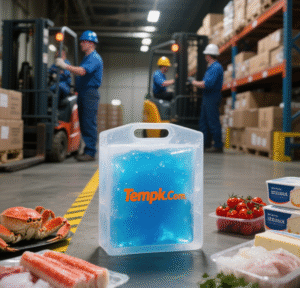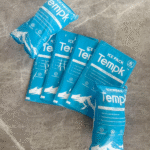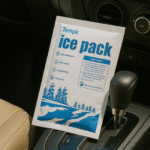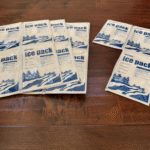Ice Packs for Shipping Frozen Food: Locking in Zero‑Degree Freshness
The global appetite for frozen meals, premium gelato, and ready‑to‑bake pastries has exploded, but every box of minus‑18 °C goodies faces a gauntlet of warm warehouses, tarmac delays, and bumpy last‑mile vans. An effective ice pack is therefore more than “frozen water in a bag”; it is a calibrated thermal reservoir that absorbs outside heat fast enough to keep product core temperatures safely below the freeze line until the customer’s freezer door swings open.

Why Sub‑Zero PCM Beats Plain Ice
Traditional gel packs plateau at 0 °C, which risks partial thawing of shrimp or cheesecake long before the delivery driver rings the bell. Phase‑change materials (PCM) engineered to melt at –20 °C or –10 °C give shippers a margin of safety by clamping internal temperatures well under the critical ice‑crystal‑growth threshold. Each kilogram of PCM can trap roughly 200 kJ of heat during its melt phase—enough to counter several hours of 30 °C ambient exposure without a temperature spike inside the carton.
Sizing the Cold Source to the Lane
Start with three numbers: payload weight, trip duration (including worst‑case holdovers), and expected ambient highs. Multiply the mass of product by its specific heat and the allowable temperature rise to calculate heat load, then add at least 25 % for safety. Compare that figure with the latent‑heat capacity printed on the PCM spec sheet. Too little coolant risks thaw; too much wastes space and freight dollars. Remember to check regulations: dry‑ice limits on aircraft or local food‑contact rules for polymer films.
Box‑Packing Best Practices
Pre‑condition PCM bricks in a –25 °C blast freezer for a full 36 h so the core is uniformly solid. Line the bottom and sides of the insulated shipper with the bricks, add a corrugated buffer, and position frozen goods centrally to reduce edge warming. Fill voids with insulated dunnage—molded pulp trays or recycled cotton pads work well—to block convection currents. Finally, tuck a temperature logger just beneath the lid for easy arrival checks and compliance audits.
Greener Cold Chains Are Possible
Frozen food is energy‑intense, but the coolant need not be landfill fodder. Biopolymer films, glycerin‑based PCM, and return‑for‑reuse programs can cut single‑use plastic and carbon output by up to 40 %. Optimizing pack size to real lane risk often halves coolant mass, trimming fuel burn without sacrificing temperature integrity.
Tempk Ice Packs: Sub‑Zero Strength, Planet‑Friendly Design
Tempk’s new Deep‑Freeze PCM Pack locks in –18 °C to –12 °C for up to 60 hours in 25 °C ambient, outperforming standard gel packs by 30 %. A quad‑layer puncture shield shrugs off fork‑lift scuffs, while a food‑grade, non‑toxic glycerin core meets FDA and EU directives. Custom dimensions—from flat flex sheets to rigid “paver” bricks—slot neatly into mailers, pouches, or pallet bins. Each unit endures 120 freeze–thaw cycles without capacity loss, and Tempk’s buy‑back program sanitizes and recirculates spent packs to keep plastics in play and out of landfills. Backed by ISO‑9001 production and full thermal test reports, Tempk ice packs give frozen‑food shippers a lighter footprint and colder cargo, lane after lane.























